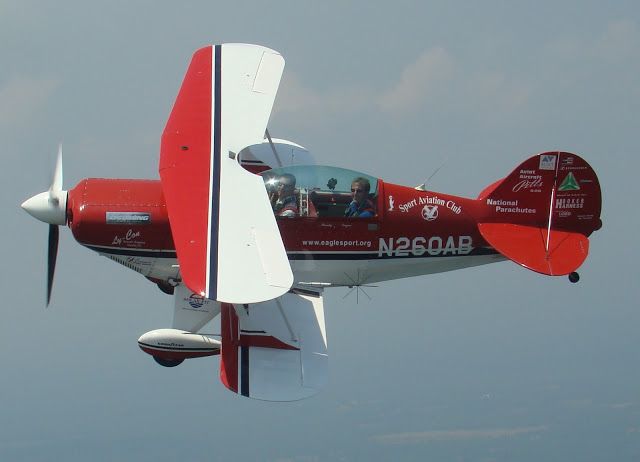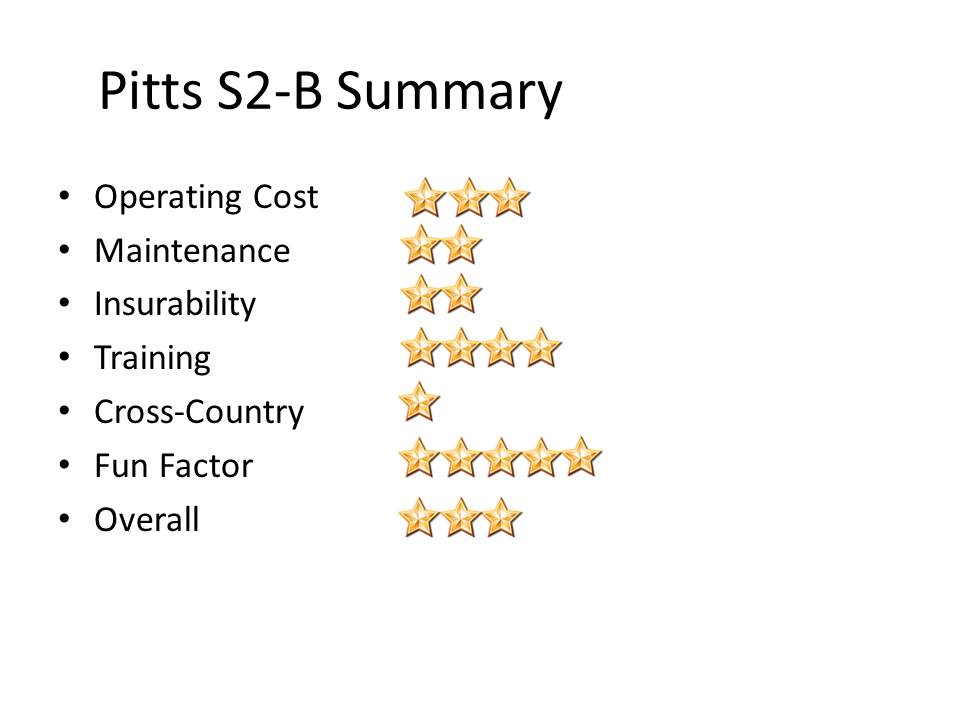 The Aircraft Spotlight feature looks at an airplane type and evaluates it across six areas of particular interest to flying clubs and their members: Operating Cost, Maintenance, Insurability, Training, Cross-Country, and Fun Factor.
The Aircraft Spotlight feature looks at an airplane type and evaluates it across six areas of particular interest to flying clubs and their members: Operating Cost, Maintenance, Insurability, Training, Cross-Country, and Fun Factor.
This month we look at the Pitts S2-B operated by Eagle Sport Aviation in Deland, FL. We talked to Instructor Jose Rojas about the club’s Pitts (N260AB), in which nearly 40 percent of all first time IAC aerobatic competitors nationwide have flown their first contest since 2003. The only other club we are aware of operating a Pitts in the U.S. is the Westwind Flying Club in Redlands, CA.
Operating Cost (3 stars)
Eagle Sport Aviation has very competitive rates for its Pitts. For every flight you’re going to spend around $210 to $240, Jose said—it’s $140 an hour dry plus fuel and instructor. Most flights last 30 to 40 minutes, so fuel is generally about $40 a flight and the instructors fees are $25 an hour—just enough to put gas in their car, Jose joked.
Maintenance (2 stars)
“The maintenance costs are pretty expensive,” Jose said. The Pitts is a tube and fabric aircraft so it has to be recovered every five years or so. Eagle Sport recovered the bottom wing recently, and that cost $8,800. Also, the 260-hp Lycoming IO-540 engine has a TBO of anywhere between 1,200 and 1,800 hours, depending on how hard you fly it. Jose said air show performers generally overhaul their engines after 500 hours. The Pitts is coming up on an engine overhaul, which Jose estimated would cost about $45,000. 
Eagle Sport flies its Pitts a lot, so there are usually three to four 100-hour inspection each year. Parts can be expensive as well. Jose said sometimes they are lucky and a part is reasonable, but other times you’ll pay $450 for something like a canopy hinge.
Insurability (2 stars)
Insurance also is expensive. Instead of paying monthly, the insurance companies requirement payment in full for the entire year. Eagle Sport carries a $1 million liability and covers the passenger, but doesn’t have much coverage on the aircraft itself. Jose didn’t say what the annual insurance is but noted that a club member who owns a Pitts S1 pays between $5,500 and $6,500 a year, and rates for a two-place Pitts are more because of the added liability of a passenger.
The club does not allow members to solo the aircraft, unless you are one of the six approved instructors.
Training (4 stars)
The Pitts attracts a wide variety of students. Eagle Sport Aviation draws many of its members from nearby Embry Riddle, which does not teach aerobatics. There are some students who do upset recovery training at Embry Riddle, get hooked, and they transition over to us for aerobatic training, Jose said.
Other students may be new instructors having trouble with stall/spin awareness and don’t want to put a kid in a spin so they get referred to Eagle Sport Aviation. “It’s no big deal in our airplane, if you do it in a Cirrus it is,” Jose said.
There also are retired military pilots who love going upside down and just want to continue to have fun flying.
Then you get the guys doing flight training who want to challenge themselves. “I knew this was something that would help develop my experience as a pilot,” Jose said. “On Michael Goulian’s website he has some high quality HD videos and one of them talks about the art of aerobatics, the art of flying. I use that video whenever I do basic introduction to aerobatics. He talks about his passion, the drive for perfection even though you can’t attain it you. Just doing that you are becoming a better person, a better pilot.”
Flying the Pitts allows a student to become more aware of things, and typically things seem to slow down when they go back to traditional flight training, Jose said. Things happen so fast in the aerobatic airplane, you have to start thinking faster.
Cross Country Travel (1 star)
A Pitts is built to tumble, not to cruise. There is no autopilot, so you are hand flying the entire flight. “The airplane is trying to be inherently neutral so a little gust of wind or if you touch the stick one way, it just wants to go,” Jose said. “There is more focus involved to keep the wings level, to keep yourself coordinated. It’s not very forgiving.”
It’s a day, VFR aircraft. There are no lights and it has no creature comforts like heat or navigation equipment, only a compass. “Unless you have a hand-held GPS or an iPad with ForeFlight, you’re looking out the window,” Jose said. “If you’re trying to take advantage of tailwinds at altitude, you’re probably going to be cold. You’ll probably be hugging your legs around the radio stack to keep warm.”
It has a 24-gallon main tank and a 5-gallon aux tank. Flight time is typically an hour and half with a half hour reserve. “If you fly the plane for an hour, you’re making too many stops, if you fly for an hour and forty minutes, you’re stretching it out and if you have to go around, you might not have enough fuel to make it half way around the pattern,” Jose said.
Eagle Sport does fly the plane to competitions, but the furthest they will fly is to Texas to the US Nationals.
Fun Factor (5 stars)
This is the reason to fly a Pitts.
“Think of when you’re doing your flight training, you’re only flying straight and level,” Jose said. “You’re able to take this Pitts and be able to roll it upside down or do a loop or just go more than 30 degrees pitch up—that can be quite exhilarating. To feel the power of the airplane pulling you through certain things, having you shoot up vertically. You start thinking how very few people do that—that can do that, that would even dare to do that.”
Need we say more?
Overall (3 stars)
If your club is looking for something completely different—something that is not only about the most fun you can have in an airplane, but also a great teaching tool for taking pilots to the next level, whether it’s an introduction into aerobatics or just building skills to be a better pilot, the Pitts is a proven airplane. It’s not going to be cheap to operate or maintain, but it is sure to add some excitement to your club.